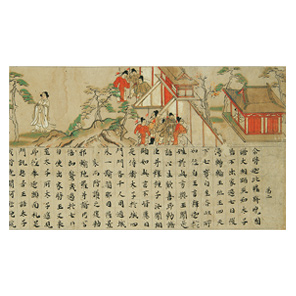HOME > Exhibitions > Past
-
Museum Collection Exhibition
Introduction to Traditional Art
The Subjects of Paintings - Saturday, May 25 - Sunday, July 7, 2019


| Closed | Mondays |
|---|---|
| Hours | 10 a.m. - 5 p.m.(last entry: 4:30 p.m.) |
| General admission | Adult 1100 yen, Student 800 yen |
| Gallery | 1/2 |
Many people think that traditional Japanese art is more difficult to approach, harder to understand, and more conservative than Western art. To make Japanese art more accessible, the Nezu Museum has planned an exhibition explaining the subject matter of Japanese paintings as the fourth in its Introduction to Traditional Art series.
In presenting the many themes addressed in Japanese paintings and their changes over time, this exhibition focuses principally on ink paintings. At first glance, some of these paintings may seem difficult to understand, but gaining a grasp of their meanings will connect to a deeper appreciation of traditional works of art.



- Illustrated Sutra of Causes and Effects
Calligraphy by Ryōsei, painted by Sumiyoshi Keinin and Shōjumaru -
Handscroll; ink and color on paper Japan Kamakura period, 13th century
Nezu Museum - Nara Period: Buddhist Paintings
This work is a Kamakura-period copy of the Illustrated Sutra of Causes and Effects, with the sutra written in the lower half and illustrations related to it painted on the upper half. While the illustrations incorporate aspects of landscape and other later-developing styles of painting, the pavilions and other elements are in the much older Nara-period style.


- The Battle of Ichi-no-Tani, Suma Bay and Akashi Bay (detail)
By Kō Sūkoku -
3 hanging scrolls; ink and color on silk Japan Edo period, 18th century Private
collection - Mounted warrior on a cliff: The Legendary Hero Minamoto Yoshitsune
In the Battle of Ichi-no-Tani, Yoshitsune led his forces to gallop on horseback down a dangerously steep cliff to make a surprise attack on the Heike clan from the rear. In this painting of one of the most famous scenes in The Tale of the Heike, the detailed depiction enhances its dramatic effect.


- Red Cliff (right screen)
By Tani Bunchō -
Pair of six-panel screens; ink and color on paper Japan Edo periods, 19th century
Nezu Museum - Full Moon and Crane: Su Dongpo's Masterpiece
On a boat beneath a towering cliff a man admires the full moon of early autumn and then, in winter, encounters a crane. This pair of folding screens is based on Ode to the Red Cliff , a famous work by the Northern Song poet Su Dongpo. With its contrast between the brutally precipitous cliffs and the glorious golden clouds, this masterwork by Bunchō depicts its richly poetic subject in a fantasy-like manner.


- The Four Favorites: Plum, Chrysanthemum, Lotus, and Wild Orchid
By Tsubaki Chinzan -
Hanging scroll; ink and color on silk Japan Edo periods, 19th century
Tochigi Prefectural Museum - Four Flowers: Symbols of Four Literati
Paintings of the “four favorites” depict the favorite flowers of four famous Chinese literati. The plum blossom symbolizes Lin Hejing, the chrysanthemum Tao Yuanming, the lotus Zhou Maoshu, and the wild orchid Huang Shangu. A theme greatly admired by literati in Japan, it is found in many extant works.










